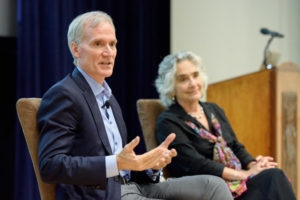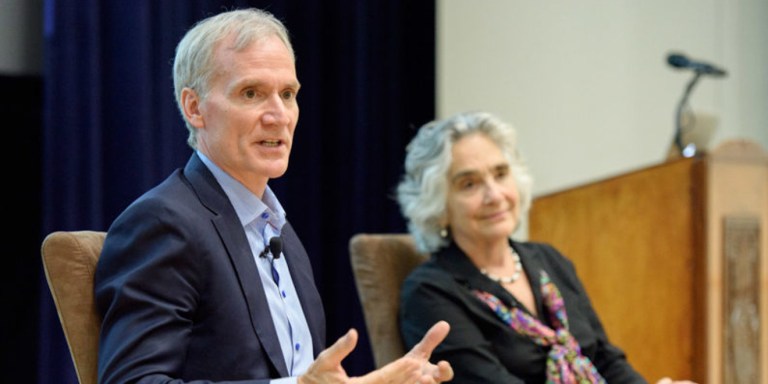
At a town hall last Friday focused on seeking suggestions for the University’s long-range planning process, students questioned Stanford President Marc Tessier-Lavigne and Provost Persis Drell about the University’s support of social justice initiatives.
The president and provost opened the floor for questions from the community after outlining the long-range planning process, which began in an official capacity with a call for ideas and proposals from individuals and groups across the University earlier this month. The long-range planning process will attempt to shape Stanford’s priorities in the next ten to 15 years and beyond.
At the meeting, questions from undergraduate and graduate students in particular centered around the University’s role in social justice initiatives, both on campus and as a force in the community.
Emma Hartung ’17 of Stanford Sanctuary Now – a group demanding University commitment to welcoming, protecting and supporting undocumented students and campus staff – asked whether the University was financially committed to supporting immigrant workers on campus through the expansion of educational opportunities for workers and legal defense against deportation.
“We are committed to the community we have, both our students and workers,” Drell responded.
In a statement to The Daily after the town hall, Hartung wrote that Drell’s response seemed lacking.
“Stanford Sanctuary Now was not satisfied with the President and Provost’s responses, or with our previous meetings with the University, because we’re still waiting for Stanford to go beyond private support and commit to the urgent and proactive actions that undocumented and immigrant communities on and off campus need,” she wrote. “The town hall was one of many signs that we need to come together as a community if we want this university to do better.”
Other concerns raised by students included University divestment from private prisons and detention centers, sexual assault on campus, affordable housing for graduate students and resources for prospective students from marginalized communities.
According to Susan B. Ford Professor of Biology Susan McConnell, who is also co-chair of the steering group that will oversee community-related proposals, one of the top priorities within the planning process is listening to concerns from students, staff and faculty.
“Right now my priority is outreach and listening – trying to understand what issues people really want to deal with, and what opportunities people would like to project into the long-range planning process,” McConnell said.
McConnell encouraged students to raise their concerns by submitting an idea or proposal through the long-range planning website between now and June, a call that Tessier-Lavigne echoed.
“It’s sufficient if you want to identify an issue, a problem, an opportunity – it’s even better and more helpful if you go on [to the long-range planning website] and give your thoughts on how we can tackle that,” Tessier-Lavigne said.
Tessier-Lavigne added that the website has received about 50 proposals since the beginning of the long-range planning process, of which only 15 percent were from students. The planning process welcomes ideas and proposals from faculty, staff, students and academic staff at all stages of development covering all aspects of the University, including those covered by the four steering groups: Education, Research, Our Community and Engagement Beyond our University.
“The important thing is to stimulate the community to think about the issues,” Tessier-Lavigne said. “We don’t want people to feel constrained by having to have a polished, finished product.”
When the first phase of proposal collection is completed in June, the steering groups will analyze the proposals, followed by a synthesis of ideas by the president, provost and executive cabinet.
The entire long-range planning process is expected to be completed by February 2018.
This article has been updated with commentary from McConnell.
Contact Zoe Sayler at [email protected].
